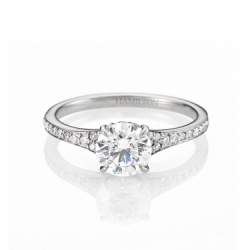Ask the Experts, Our Engagament Ring Guide!
The Top 3 Things to Know Before You Start This Amazing Adventure:
- What is your budget?
- What setting is best?

Solitaire- A single stone. Still the most popular choice in engagement rings.

Three Stone- Best described as ‘One diamond for the past, one for the present, and one for the future.’

Sidestone- Diamonds or other gemstones flank the main stone for additional sparkle or color.

Vintage Inspired- Designs that are vintage inspired often have halo settings and filigree details to further enhance the ring.
- What is her style/taste?
And yes, the 4 C’s are really important…
You don’t need to obtain a gemology degree, but you should have a basic understanding of what contributes to a diamond’s value and appearance. And as fundamental as it sounds, there IS a fifth “C”…Confidence in your jeweler. Ask for referrals --- be sure you’re buying from a reputable jeweler who is a member of either the Gemological Institute of America (GIA) or the American Gem Society (AGS).
Carat
The concept her is straightforward: Carat refers to the weight of a diamond. However, there’s no need to focus solely up on the carat weight number. Through proper mounting and shaping, a master jeweler can make a diamond appear larger than its carat weight might suggest, while also bringing out its maximum brilliance.
Clarity
Evaluators of diamonds base part of the value on luster and sheen. These relate to the clarity of the stone. You can spend less on a very large but cloudy diamond for example, than on a small but transparent and shiny one. The important thing to bear in mind, however, is that the less flaws visible to the naked eye, the more valuable the stone.
Cut
A good cut determines the amount of light that can enter into the stone, refract, and emit that brilliant quality that people love in a diamond. Cut doesn’t refer to the shape of the diamond, but rather the angles and proportions of the stone. While nature determines the other three C’s, the diamond’s cut is determined by a cutter. A well cut diamond refl ects light from one facet to another and projects the light through the top of the stone… giving a diamond its sparkle. Out of all the four C’s, cut is the most important. Even if you have the perfect color, clarity, and carat, if the cut isn’t right, the diamond won’t have that fiery brilliance that your fiancé willbe proud to show the world.
Color
To the surprise of many people, diamonds come in a variety of colors. Diamond color is graded on a scale that ranges from D (colorless) to Z (light yellow). Truly colorless diamonds are the rarest, most exquisite.





